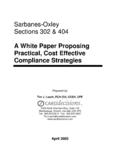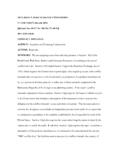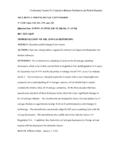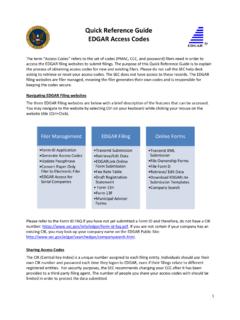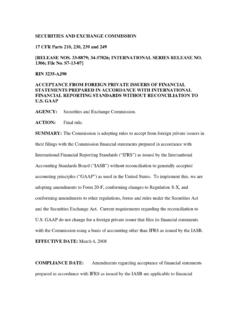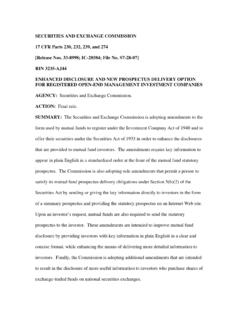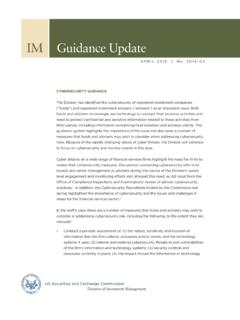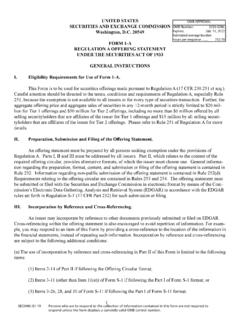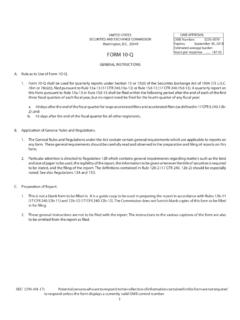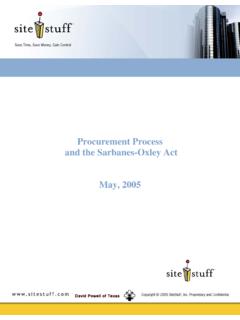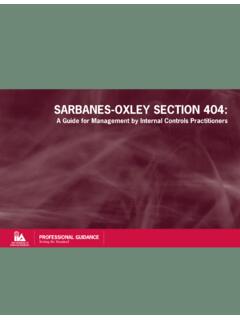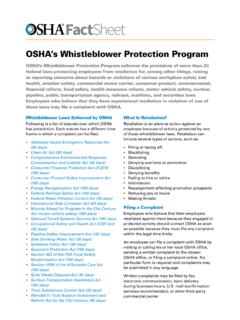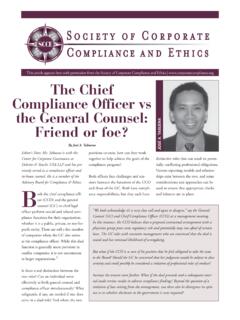Transcription of Report on the Role and Function of Credit Rating Agencies ...
1 Report on the Role and Function of Credit Rating Agencies in the Operation of the Securities Markets As Required by Section 702(b) of the Sarbanes- oxley Act of 2002 Securities and Exchange Commission January 2003 i TABLE OF CONTENTS EXECUTIVE 1 I. INTRODUCTION .. 3 II. BACKGROUND A. General .. 5 B. Regulatory Use of Credit Ratings .. 6 C. Recognition of NRSROs .. 8 1. NRSRO Recognition Criteria .. 9 2. Recent Initiatives.
2 10 a. 1994 Concept Release ..10 b. 1997 Rule Proposal ..12 III. RECENT INQUIRIES INTO THE ROLE OF Credit Rating Agencies A. Senate Initiatives .. 16 1. Enron-Related Credit Rating Agency Hearing .. 16 2. Governmental Affairs Committee Staff Report .. 17 B. Commission Initiatives .. 18 1. Broad-Based Commission Review .. 18 2. Commission Examinations of NRSROs .. 19 3. Credit Rating Agency Hearings .. 20 a. Current Role and Functioning of Credit Rating Agencies .
3 21 b. Information Flow in the Credit Rating Process .. 21 c. Concerns Regarding Credit Rating Agencies ( , Potential Conflicts-of-Interest or Abusive Practices) .. 23 i. Issuer Influence .. 23 ii. Subscriber Influence .. 23 iii. Advisory Services .. 23 iv. Abusive Practices .. 24 d. Regulatory Treatment of Credit Rating Agencies (including Concerns regarding Potential Barriers to Entry) .. 24 IV. DISCUSSION A.
4 Role of Credit Rating Agencies in the Evaluation of Issuers of Securities .. 25 1. General Procedures for Evaluating Issuers .. 25 2. Rating Committee Process .. 26 3. Rating Decisions and Publication .. 26 B. Importance of the Role of Credit Rating Agencies to Investors and the Functioning of the Securities Markets .. 27 1. Issuers .. 27 2. Buy-Side Firms .. 28 ii 3. Sell-Side Firms.
5 28 4. Regulatory Use of Ratings .. 28 5. Use of Ratings in Private Contracts .. 29 C. Impediments to the Accurate Appraisal of Issuers by Credit Rating Agencies 30 1. Level of Public Disclosure by Issuers .. 30 2. Diligence and Qualifications of Credit Rating Agency Analysts .. 31 D. Measures to Improve the Dissemination of Information by Credit Rating Agencies .. 32 1. Transparency of Ratings Process .. 33 2. Preferential Subscriber Access to Information .. 35 3. Public Availability of Ratings.
6 36 E. Barriers to Entry into the Business of Acting as a Credit Rating Agency Measures Needed to Remove Such Barriers .. 36 F. Conflicts of Interest in the Operation of Credit Rating Agencies Measures to Address Such Conflicts .. 40 1. Issuers Paying for Ratings .. 41 2. Development of Ancillary Businesses .. 42 V. CONCLUSION .. 43 Report ON THE ROLE AND Function OF Credit Rating Agencies IN THE OPERATION OF THE SECURITIES MARKETS As Required by Section 702(b) of the Sarbanes- oxley Act of 2002 EXECUTIVE SUMMARY The Securities and Exchange Commission ( Commission or SEC )
7 Has prepared this Report on the role and Function of Credit Rating Agencies in the operation of the securities markets in response to the Congressional directive contained in the Sarbanes- oxley Act of 2002 ( Sarbanes- oxley Act ).1 The Report is designed to address each of the topics identified for Commission study in the Sarbanes- oxley Act, including the role of Credit Rating Agencies and their importance to the securities markets, impediments faced by Credit Rating Agencies in performing that role, measures to improve information flow to the market from Rating Agencies , barriers to entry into the Credit Rating business, and conflicts of interest faced by Rating Agencies .
8 As the Report called for by the Sarbanes- oxley Act coincided with a review of Credit Rating Agencies already underway at the Commission, the Report addresses certain issues regarding Rating Agencies , such as allegations of anticompetitive or unfair practices, the level of diligence of Credit Rating Agencies , and the extent and manner of Commission oversight, that go beyond those specifically identified in the Sarbanes- oxley Act. While the Commission has made significant progress in its review of Credit Rating Agencies , and identified a wide range of issues that deserve further study, much work remains to be done.
9 Accordingly, the Commission plans to publish a concept release within 60 days of this Report to address concerns related to Credit Rating Agencies and expects to issue proposed rules, after reviewing and evaluating the comments received on the concept release, within a reasonable period of time after the close of the comment The Commission hopes to elicit extensive comments on these issues, from market participants, other regulators, and the public at large.
10 The issues to be studied by the Commission in more depth include the following: Information Flow Whether Rating Agencies should disclose more information about their ratings decisions. Whether there should be improvements to the extent and quality of disclosure by issuers (including disclosures relating to ratings triggers). 1 Sarbanes- oxley Act of 2002, Pub. L. No. 107-204, 702(b), 116 Stat. 745 (2002). 2 The Commission is mindful that some of the concepts discussed in this Report may raise questions about the limits of the Commission s authority.
